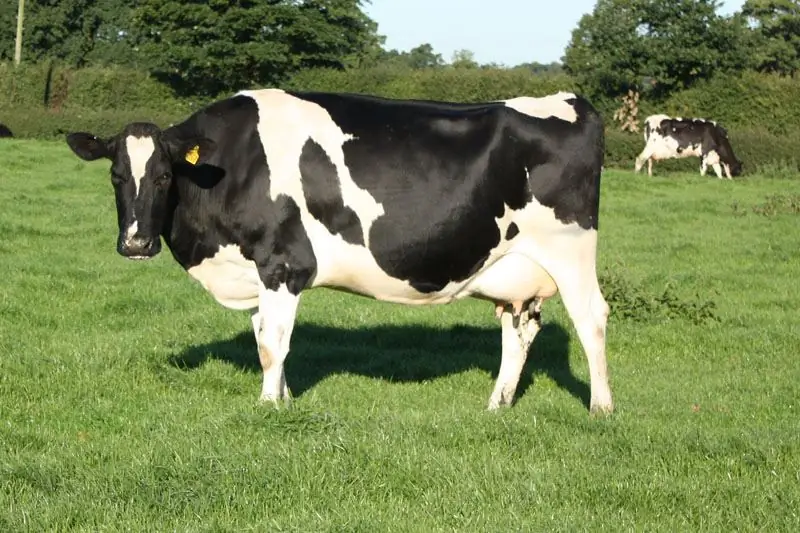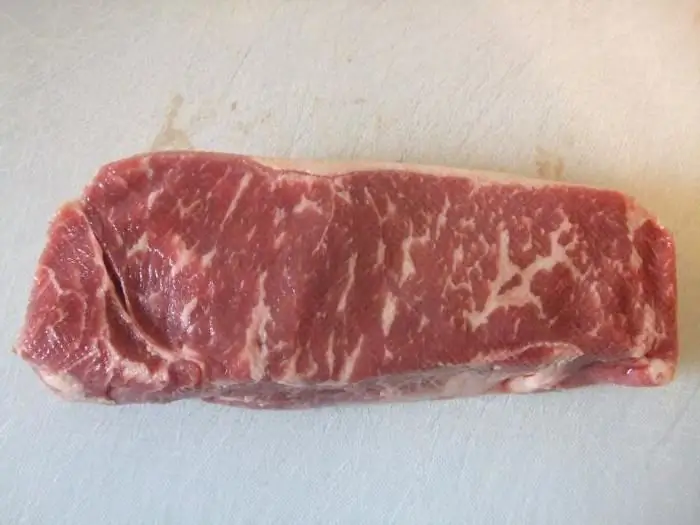2026 Author: Howard Calhoun | [email protected]. Last modified: 2025-01-24 13:10:25
Of course, cows on farms owned by Russian farmers are bred mainly for milk. However, in some cases, cattle are also raised for meat. It is believed that such a farm can be profitable only if purebred cattle are raised. With the same diet, such cattle gain weight much faster than hybrids. One of the best breeds of cows for meat productivity is the Kazakh white-headed.
A bit of history
This highly productive cattle was bred back in Soviet times by breeders from Kazakhstan and the Lower Volga region. At that time, the Hereford, Kazakh and Kalmyk breeds were used as parental specialists. Subsequently, the individuals obtained by crossing were bred "in themselves", selecting the most productive bulls and cows. The Kazakh white-headed breed was approved as an independent breed in 1951.

From the Hereford cattle, representatives of this species received such valuable qualities as high meat yield and rapid weight gain. From Kazakh bulls to this cattlegot a strong body. Selection work is carried out with this breed in our days. The efforts of specialists are aimed primarily at improving, of course, its meat qualities. The best breeding cattle of the Kazakh white-headed breed is concentrated today in the Volgograd region, at the breeding farm "Red October". These cattle are improved here both by renewing blood when using Herefords, and by selecting the best representatives.
External signs
Besides the massive body, the Kazakh white-headed breed is different:
- stretched barrel-shaped torso;
- very flat back line;
- strong, relatively light bones.
The color of the cows of this breed is red in different shades. The head, dewlap, tail, lower belly and legs are white. A feature of the cattle of this breed is the fact that by winter it is overgrown with thick long hair. Therefore, it is possible to keep such bulls and heifers in the most severe climate.

Kazakh white-headed species
At the moment, two main lines of this cattle are bred on farms: meat and meat and dairy. The first type is the main one. In farms containing meat-type animals, the technique of long-term grazing on pastures is mainly practiced. Calves on such farms are raised on suction. In winter, livestock are given mainly concentrates, silage and roughage.
In farms specializing in the cultivation of the Kazakh white-headed meat and dairy line,slightly different methods of caring for animals are used. In this case, the calves are weaned from the uterus after some time. The selection of livestock in such farms is carried out both for meat and dairy characteristics.
Cattle productivity
Kazakh white-headed cows weigh an average of 540-580 kg. In some cases, this figure can reach 700 kg. Gobies of the Kazakh white-headed breed by the time of slaughter gain weight of 800-850 kg. The body weight of the best individuals can reach up to 1000 kg.
The yield of meat from this cattle is about 53-63%. The record figure was 74.3%, obtained from specially fattened bulls. The meat of these cows, judging by the reviews of farmers, has a very good presentation. At the same time, it has simply excellent taste. It is valued primarily for its juiciness and the presence of fat deposits between the muscles.

Cattle of the meat and dairy direction of this breed is also quite good in productivity. It is believed that keeping such cows is quite profitable. For lactation from one Kazakh white-headed cow, you can get about 1.5-2.5 thousand kg of milk. Record figures in this regard are 6000 kg per year. And this, in turn, is comparable with milk yield from cows of a purely dairy direction of productivity. So, for example, a black-and-white and red steppe cow can produce 4-6 thousand kg of product per lactation.
The fat content of the milk of the Kazakh white-headed cow is about 4%. This indicator is actually very good. Most bred in Russiacow gives milk of exactly this fat content.
Kazakh white-headed breed of cows: content features
These animals are mainly reared in a loose way indoors or on outdoor walking areas. For calves of this breed, exceptionally clean pens without drafts are suitable. In the summer, Kazakh white-headed cattle are driven out to pastures. The most profitable is the content of this cattle in a free-range way.

In the premises intended for the rest of cows, a non-removable straw bedding is usually laid with a layer of 25-30 cm. It is updated daily at the rate of 3 kg per animal. During the stall period, the thickness of the litter, thus, reaches 1 m. These animals are usually driven into the barn only in severe frosts.
The walking areas on the farm are being built on the south side. Their size should be such that one cow accounts for at least 8 m2 of area with a hard cover and about 25 m2 in its absence. Feeders are installed along the perimeter of the paddock. The doors of the barn with this kind of livestock should be constantly open.
For the winter, Kazakh white-headed bulls and cows, as already mentioned, are overgrown with thick wool, and therefore they can be grazed at this time of the year. Usually, artificial pastures are arranged for meat-producing cattle. In this case, double slanted swaths of high-stalked plants are laid on the fields in autumn. Also in wintercows of this breed can also be grazed on natural pastures with long grass.
Feeding
In terms of diet, the Kazakh white-headed cow is absolutely unpretentious. Many farmers keep these cows on this menu:
- in the morning - water, crushed grain, hay;
- in the evening - straw, crushed wood, water.
Crushers at the same time it takes a little for one animal. Five cows will need a full bucket of 15 liters per day. Hay should be given freely to livestock. In winter, it is desirable to increase the amount of concentrates for cows.

Kazakh Whitehead Juvenile
Maternal instinct in cows of this breed is very well developed. This is primarily due to the fact that Kazakh meat white-headed calves are kept on suction. Since the young are with their mother for a long time, there is practically no lunge in such cattle. Calves of this breed are born very large. Their weight after calving is about 27-30 kg. But despite this, childbirth in cows, since they are also large in size, is very easy. Complications in these cows are extremely rare.
The calves themselves from these cows are born he althy and strong. They get sick only in exceptional cases. They do not have congenital pathologies. Until the bull or heifer grows up, the mother is next to them and shows maximum care for them. Even if the owner does not fulfill any special requirements for the maintenance of calves, absolutely nothing will happen to them. Of coursethis greatly facilitates the farmer's task of raising young stock.
The growth of beef calves of this breed largely depends on the milk productivity of cows. Young growth of the Kazakh white-headed breed is grown up to 18-20 months. By this time, he manages to work up lethal body weight. With intensive fattening, the growing period is reduced to 12 months. The live weight of calves per year increases to approximately 450 kg.
Feedback from farmers about the breed
The opinion of the owners of farms specializing in the breeding of the Kazakh white-headed cattle is relatively good. This cattle received good reviews primarily for:
- correct physique;
- quick weight gain even with a fairly meager diet;
- no coverage issues.

In terms of the productivity of the Hereford breed, the Kazakh white-headed breed, according to most farmers, unfortunately, is inferior. However, at the same time, it is much more adapted to the harsh conditions of the steppe zone of Russia. In addition, this cattle, unlike the Hereford, is not at all afraid of long hauls.
The advantage of this cattle, among other things, is considered to be undemanding in terms of feed quality. They eat such cows literally everything. If necessary, it is allowed to give these cattle both barley and wheat straw. Approximately 60% of all roughage fed is this product.
Of course, weather endurance also applies tounconditional advantages of cows of this breed. It is believed that this cattle can be kept at temperatures from +50 to -40 degrees. And without losing productivity.

Kazakh white-headed calf price
Thus, the reviews of farmers of this breed deserved really very good. The cost of Kazakh white-headed calves, like any other breed, is usually determined by their live weight. The price for young animals of 200-300 kg, for example, is 140 rubles per kilogram. The cost of cattle of this breed of meat and meat and dairy productivity is approximately the same. Hereford cattle, pictured above, are gaining more body weight, and therefore usually cost more.
Recommended:
Breeds of cows: description and characteristics. Dairy breed of cows

Let's figure out what breeds of cows are in demand among domestic farmers and breeders, why they are remarkable, and also consider the main advantages and disadvantages of certain individuals
Who is a "dominant"? Breed of chickens "dominant": description of the breed, characteristics and reviews

Who is a "dominant"? These are friendly, unpretentious, beautifully colored chickens that are great for keeping on farms and on a private plot. They do not require large expenditures for maintenance and feeding, but they are distinguished by very high productivity and longevity. They lay eggs not only for domestic use, but also for sale
Simmental, breed of cows: photo and description, characteristics, pros and cons of the breed

The Simmental cow breed is one of the most ancient. It is versatile, has both excellent meat and dairy characteristics. Simmental bulls gain weight very quickly. Their meat has a pleasant taste, so farmers often take them for fattening. Simmental cows produce excellent fat milk, which is perfect for making cheeses. They give birth to strong calves and have stable lactation
Red steppe breed of cows: characteristics, photos, breeding features

Red steppe breed of dairy cows is defined as one of the best in the post-Soviet space. Animals are perfectly adapted to the dry climate of the steppe zones
Sychevskaya breed of cows: description, characteristics, photos, reviews

All over the world, thanks to the work of breeders, there are more than 1000 breeds of cattle. All of them have different characteristics, productivity and directions. Breeds of cattle can be divided into three groups: meat, dairy, universal (meat and dairy). When choosing an animal for your farm, pay attention to what kind of livestock is common in your area. Today we will consider the most popular breed of cows in our country - Sychevskaya

